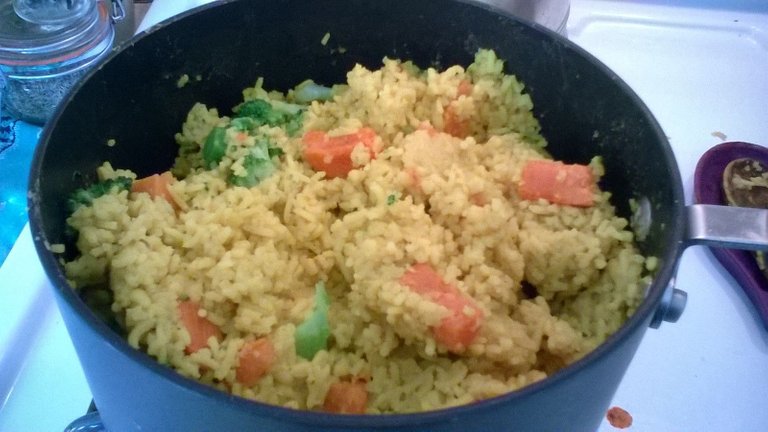Alright, here's a new little food adventure I'd like to share with you all. I recently heard about an Indian food recipe called Kitchari, a dish commonly used in Ayurvedic medicine to improve one's health, especially digestion. Apparently, many people use this dish as part of a cleanse, eating nothing buy Kitchari for days on end. I was intrigued by this dish as I've never heard of a cleanse that includes eating rice; on the contrary, most cleanse diets have you completely avoid most starches like wheat, rice and potatoes altogether! How could rice be cleansing? Apparently, Basmati rice, which is what is called for in Kitchari, is highly digestible, so even though it is starchy, it is easy for your body to process.

Here's the basis of Kitchari, Basmati rice and yellow moong (or mung) dal (or beans). Yellow moong dal is just green mung beans de-husked. I've read elsewhere that you can use regular mung beans, but the husked yellow ones are supposedly easier to digest without the tough, green skins. The Basmati rice should be white, not brown, again for digestibility. So the emphasis on this recipe is not eating a lot of fiber to clean you out, but rather to eat something that breaks down quickly and more or less gives your digestive system a rest while still giving you quality nutrition to keep you going.
The spice in the photo is asofoetida, a very pungent plant resin. This spice is totally new to me, but I understand a great deal of Indian food is made with it. It can come in powdered or in a block of resin like this, and it supposed to marvelous for improving your digestion. I must say, it really stinks at first...I don't know how to describe it, except maybe like sulfuric fennel. Store in in something airtight, because I can see how this would make all your other spices and food stink if you left it open near them. This is an important ingredient in Kitchari along with some other common Indian spices. Kitchari recipes vary on what spices to include, but I used what I had on hand: turmeric, cumin, cinnamon, mustard seeds, asofoetida and a bit of a pre-made curry blend. Many recipes also call for fennel and coriander.
So this is not an exact recipe, but here's the basics of what I did. I started by soaking a 1/2 cup of the yellow dal in water. I soaked mine overnight, although just a couple hours would suffice. Soaking is not even required, but it may aid in improved digestibility. Wash but don't soak about twice as much rice as you have dal and keep to the side.
Get all your spices together and heat some oil in a large saucepan, using either coconut or sesame oil. When the oil is hot, toss in your spices and stir until the mustard seeds start to pop. Now dump in your yellow dal and the rice and add enough water to cover the whole thing by about an inch.
Stir together and bring to a brief boil, then turn down to a simmer. At this point, you can add some veggies, such as sweet potato, squash or pumpkin. Do NOT add any onion or garlic to this, as these are "drying" in Ayurvedic medicine and are not what we want if we're eating this for cleansing purposes. Save any quicker cooking veggies like kale or greens until the end.
Stir occasionally until the rice and dal are pretty soft, then turn off the heat and serve. Add a quality sea salt and pepper to taste. You can add some optional toppings like unsweetened coconut or cilantro as well as tamari or Braggs liquid aminos for extra flavor.
This is a simple dish and while somewhat bland compared to a lot of Indian food, it is filling and comforting. While you can use this as part of a cleanse, you can also just eat it for a single meal.
Those of your with more experience cooking Indian food, let me know if you make Kitchari and your spin on it!

Oh, nice - that looks really good right now.
The only thing I would change is adding onion, garlic and hot sauce or chili to this, but apparently you're not allowed to add that if you're eating it for a cleanse. It would have had more flavor.